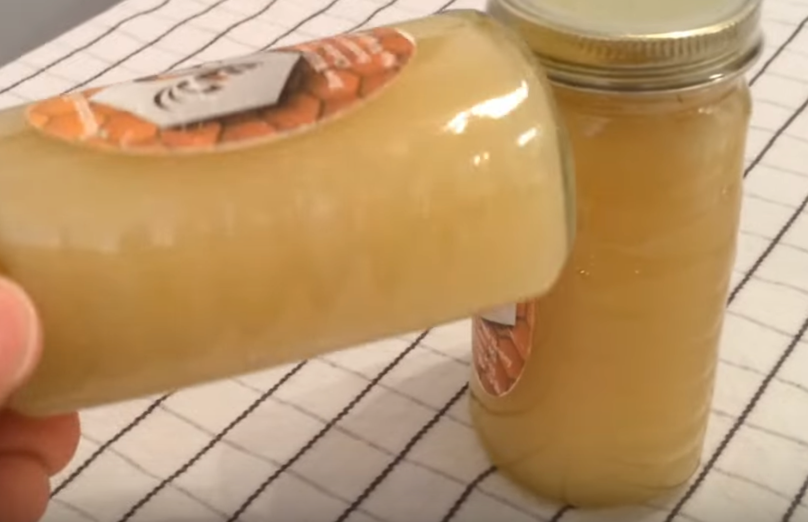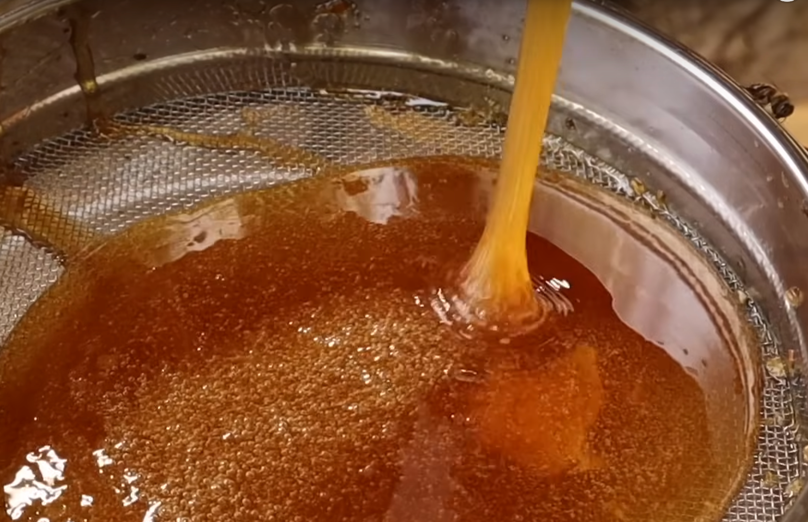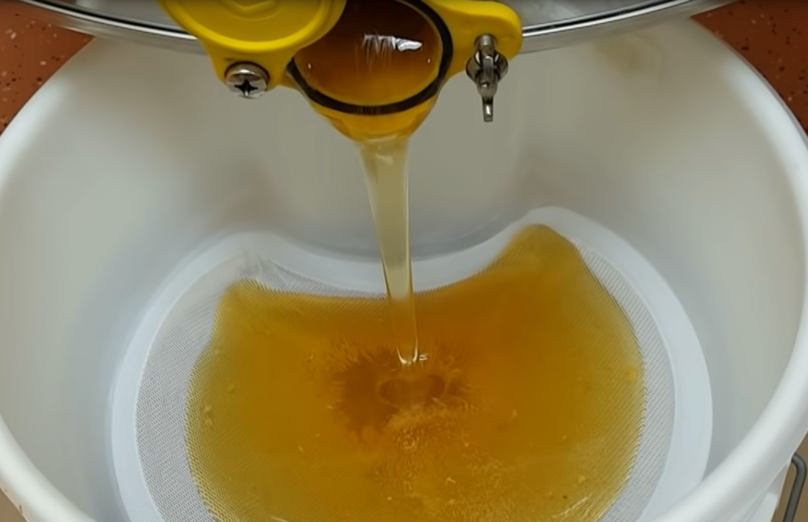Did you know that ancient Egyptians called honey “the food of the gods”? They were onto something! But even the gods’ favorite treat has its quirks – like crystallization.
You’ve probably seen it happen: your smooth, runny honey suddenly becomes grainy and solid. But fear not, honey lovers! This natural process isn’t a sign of spoilage – it’s a testament to honey’s purity. In fact, some people prefer their honey crystallized!

Today, we’re diving deep into the sweet science of honey crystallization. From the why to the how, and everything in between, let’s unravel this sticky mystery together!
The Science Behind Honey Crystallization
Let me tell you about honey crystallization! It’s like a magic trick that happens right in the jar. I’ve been fascinated by this process ever since I found my first jar of honey turned solid. Talk about a surprise!
Chemical Composition Of Honey: Sugars And Their Role
So, here’s the deal with honey’s chemical makeup. It’s basically a super-concentrated sugar solution. You’ve got fructose, glucose, and a tiny bit of sucrose swimming around in there. The star of the crystallization show is glucose. This little sugar molecule is the troublemaker that starts the whole process.
Factors Influencing Crystallization: Temperature, Moisture, And Nectar Source
Now, what makes honey crystallize? It’s like a perfect storm of conditions. Temperature is a big player. I learned this after I left a case of honey in my cold garage. Come spring, it was all crystallized! Turns out, honey loves to crystallize between 50-59°F. Who knew?
The Crystallization Process: From Liquid To Solid
Moisture content is another biggie. The less water in your honey, the faster it’ll crystallize. I once had a batch of super-dry honey that turned solid in weeks! And don’t even get me started on the nectar source. Some flowers, like canola and dandelion, produce honey that crystallizes faster than you can say “beeswax”!
The actual process is pretty cool. It starts with tiny glucose crystals forming. These act like magnets, attracting more glucose molecules. Before you know it, you’ve got a solid mass of honey. It’s like watching a tiny, sweet glacier form in your jar.
Here’s a fun fact: all raw honey will crystallize eventually. It’s totally natural! I remember freaking out the first time it happened to my homemade honey. Now I know it’s just honey doing its thing.
Some people prefer their honey liquid, but I’ve grown to love the creamy texture of crystallized honey on my toast. It’s like nature’s butter! Plus, it’s easier to spread without dripping all over the place.
Just remember, crystallized honey isn’t spoiled. A warm water bath will bring it right back to liquid if that’s your preference. Isn’t nature amazing?
Types Of Honey Crystallization
Alright, honey lovers, let’s dive into the sweet world of crystallization types! I’ve seen ’em all in my beekeeping adventures, and wow, do they each have their own personality.
Fine Crystallization: Smooth And Creamy Texture
First up, fine crystallization. This is the cream of the crop, literally! I remember the first time I achieved this perfect, smooth texture. It was like spreading silk on my toast!
The key is tiny crystals that give the honey a creamy, almost buttery feel. It’s a hit at farmer’s markets, let me tell you. People go nuts for that spreadable consistency.
Coarse Crystallization: Gritty And Granular Feel
Now, coarse crystallization – that’s a whole different ballgame. I had a batch turn out like this once, and it was like spreading sand on my bread! Not exactly what I was going for.
These big, chunky crystals give the honey a gritty, granular texture. Some people love it, though. It’s all about personal preference.
Partial Crystallization: A Mix Of Liquid And Crystals
Then there’s partial crystallization. This one’s a troublemaker. Half liquid, half solid – it’s like honey’s going through an identity crisis! I once bottled a batch that looked perfect, only to find it had partially crystallized a week later. Talk about a surprise when you open the jar!
The funny thing is, all these types can happen naturally. It’s like honey’s got a mind of its own sometimes. I’ve had identical jars from the same batch crystallize differently. Go figure!
Temperature plays a big role in how honey crystallizes. I learned this the hard way when I stored some jars in my basement. The cooler temps led to faster, coarser crystallization. Now I keep some of my honey at a steady room temperature to encourage that fine, creamy texture.
No matter how your honey crystallizes, it’s still good to eat. Don’t toss it out thinking it’s gone bad! Just warm it up gently if you prefer it liquid. Or better yet, embrace the variety and enjoy each unique texture. After all, that’s part of the fun of real, raw honey!
Factors Affecting The Speed Of Crystallization
Let me tell you, the speed of honey crystallization is like a race where every contestant has a different pair of shoes! I’ve seen some honeys turn solid faster than I can say “beeswax,” while others stay liquid for ages.
Fructose To Glucose Ratio In Different Honey Varieties
First up, let’s talk about the fructose to glucose ratio. It’s like the honey’s secret formula. I once had two jars side by side – one crystallized in a week, the other took months. Turns out, the quick-crystallizing one was from clover, which has more glucose. The slow one? Tupelo honey, which is mostly fructose. It’s like nature’s own science experiment!
Impact Of Storage Temperature On Crystallization Rate
Now, storage temperature – that’s a biggie. I learned this after I left a case of honey in my garage over winter. Come spring, it was solid as a rock! Honey loves to crystallize between 50-59°F.
Any colder, and it slows down. Warmer, and it stays liquid longer. Now I keep my honey at room temp to control crystallization.
Role Of Pollen And Other Particles In Crystal Formation
And don’t forget about pollen and other particles. They’re like little seed crystals, giving glucose molecules something to latch onto. I once strained my honey super-fine, thinking I was being clever. Guess what? It took forever to crystallize! A little pollen can actually be a good thing.
Here’s a fun fact: some beekeepers use a technique called “seeding” to control crystallization. They add finely crystallized honey to liquid honey to kickstart the process. It’s like giving crystallization a head start in the race!
Fast or slow crystallization doesn’t mean good or bad honey. It’s just honey doing its thing. Whether you like it liquid gold or creamy solid, it’s all sweet in the end!
Controlling The Crystallization Process
Let’s dive into the sweet science of controlling honey crystallization! I’ve had my fair share of crystallization surprises, so I’ve picked up a few tricks along the way.
Techniques For Promoting Controlled Crystallization
First off, promoting controlled crystallization. This is where the magic happens, people! I remember my first attempt at creamed honey – what a mess!
But once I got the hang of it, wow! The key is “seeding.” You mix in some finely crystallized honey to your liquid gold, and it’s like giving those glucose molecules a roadmap. I use about 10% seed honey and keep it at a cool 57°F. Works like a charm!
Methods To Prevent Or Slow Down Crystallization
Now, sometimes you wanna keep that honey flowing. To slow down crystallization, heat is your friend. But easy does it! I once overheated a batch and killed all the good enzymes. Rookie mistake! Now I use a water bath at about 95°F. It’s gentle enough to keep the honey’s benefits intact.
Storage is crucial too. Room temp is generally best for slowing crystallization. I keep my honey in a dark cupboard – light can speed up the process. Who knew honey was such a drama queen about its environment?
Oh, and here’s a pro tip: stirring your honey occasionally can help prevent crystallization. It breaks up those pesky glucose crystals before they can form. Just don’t go overboard – you’re not making a smoothie!
The Art Of Creamed Honey: Intentional Crystallization
Now, let’s talk creamed honey. This stuff is the bee’s knees! It’s all about controlled crystallization to get that smooth, spreadable texture. The trick is using very fine seed crystals and maintaining a steady temp during the process. I spent a whole season perfecting my technique, but man, was it worth it! My creamed lavender honey is a hit at the farmer’s market.
Whether you’re promoting or preventing crystallization, patience is key. Honey’s got its own timeline, and sometimes you just gotta roll with it.
Decrystallizing Honey: Methods And Precautions
Let’s talk about turning that solid honey back into liquid gold! I’ve had my share of crystallized honey emergencies, and let me tell you, it’s all about being gentle.
Gentle Heating Techniques To Liquefy Crystallized Honey
First up, heating techniques. I remember the time I tried to microwave a jar of crystallized honey. Big mistake! It turned into a hot, foamy mess.
Now, I swear by the warm water bath method. Just plop your honey jar in some warm water (around 95°F) and let it do its thing. It’s like a day at the spa for your honey!
Risks Of Overheating: Preserving Honey’s Nutritional Value
But here’s the kicker – you gotta be careful not to overheat. I learned this after I got impatient and cranked up the heat. Ended up with a batch of honey that lost all its wonderful enzymes and flavors. What a waste! Remember, anything over 110°F is danger zone for honey’s good stuff.
Oh, and here’s a neat trick I picked up from an old-timer beekeeper: use your slow cooker! Set it on low, fill it with water, and let your honey jars take a nice, slow bath. It’s foolproof!
Using Ultrasonic Devices For Decrystallization
Now, let’s talk about these fancy ultrasonic devices. I was skeptical at first – sounded like sci-fi mumbo jumbo to me. But I gave it a shot with a stubborn batch of crystallized honey, and wow, was I impressed! It’s like magic – no heat needed. The ultrasonic waves break up the crystals without damaging the honey. Pretty nifty, huh?
Just remember, no matter what method you choose, patience is key. Rushing the process is a surefire way to ruin good honey. And if you ask me, there’s nothing wrong with a little crystallization. It’s just honey being honey!
Oh, and here’s a pro tip: if you’re dealing with a big bucket of crystallized honey, try using a honey pump heater. It’s a how large operations deal with their crystallized honey.
The Impact Of Crystallization On Honey Quality
Alright, let’s dive into the sweet world of honey crystallization! I’ve been keeping bees for almost 15 years now, and wow have I learned a thing or two about how crystals can shake things up in that golden goodness.
Flavor And Texture Changes During Crystallization
When it comes to flavor and texture, crystallization’s like that friend who shows up uninvited to your party – it changes everything! At first, I thought my honey had gone bad when I saw those little crystals forming. But turns out, it’s just nature doing its thing.
The texture gets grainier, sure, but the flavor? It can actually intensify in some cases. I’ve noticed my wildflower honey gets a bit more complex after crystallizing. It’s like the flavors decided to have a little party of their own.
Nutritional Value: Does Crystallization Affect It?
Now, about nutrition – don’t let anyone tell you crystallized honey is less healthy. That’s a load of hogwash! I remember freaking out and tossing a whole jar once because I thought it had “gone bad.” What a waste!
The truth is, crystallization doesn’t mess with the good stuff in honey. All those enzymes, antioxidants, and other fancy nutrients? They’re still there, just chillin’ in a different form.
Shelf Life And Storage Considerations For Crystallized Honey
Speaking of chillin’, let’s talk storage. Crystallized honey’s actually a bit of a diva when it comes to shelf life. It can last pretty much forever if you treat it right. I keep mine in a cool, dark cupboard – learned that after leaving a jar on the windowsill. Talk about a sticky situation!
The key is to avoid temperature fluctuations. They make the crystals grow faster, and before you know it, you’ve got honey concrete.
One thing I’ve picked up over the years: don’t knock crystallized honey till you’ve tried it on toast. It’s like nature’s crunchy peanut butter, I swear. And if you’re not a fan of the texture, a warm water bath’ll smooth things out. Just don’t overheat it, or you’ll end up with honey-flavored syrup. Trust me, been there, done that!
The Final Buzz
And there you have it, the sweet scoop on honey crystallization! From understanding the science to mastering the art of controlled crystallization, we’ve journeyed through the fascinating world of nature’s golden treat.
Crystallization is a sign of honey’s natural goodness, not a flaw. Whether you prefer your honey smooth and runny or creamy and crystallized, it’s all part of the wonderful diversity of this ancient food.
So next time you see those beautiful crystals forming in your honey jar, you’ll know exactly what’s happening – and maybe you’ll even impress your friends with your honey knowledge! Keep exploring, keep tasting, and most importantly, keep enjoying the sweet life! Happy honey-ing, folks!



